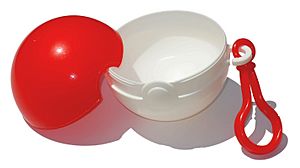Burger King Pokémon container recall facts for kids
In 1999 and 2000, Burger King and the Consumer Product Safety Commission (CPSC) worked together to recall plastic containers shaped like Poké Balls. These containers were given out with kids' meals in the United States. They were recalled because they were found to be a danger, as they could cause a child to suffocate. This recall was one of the biggest and most expensive in history.
Contents
What Happened
In late 1999, Burger King started a big promotion for Pokémon: The First Movie. They offered 57 different Pokémon toys in their kids' meals. Each toy came inside a round plastic container that looked like a Poké Ball. These containers came in different colors, like red and white or hot pink. You could open them by pulling the two halves apart. The promotion was planned to last for eight weeks.
Why the Recall Happened
Sadly, on December 11, 1999, a 13-month-old girl in California died after one of these containers covered her nose and mouth. After this tragic event, the local police warned parents about the containers. This was the first time a Burger King toy was linked to a death.
Two days later, the CPSC asked Burger King to recall the containers. At first, Burger King didn't want to. They wanted to wait for more proof that the container caused the death. However, the CPSC explained that the container's design was dangerous. It was just the right size to cover a child's nose and mouth. Because the plastic was flexible, a child could suck the air out, making the container stick to their face. The more a child breathed, the tighter it would stick. The CPSC called this a "hidden danger" that parents might not expect.
On December 23, another incident happened where an 18-month-old girl in Kansas got half of a Poké Ball stuck on her face. Luckily, her father was able to remove it. After this, Burger King agreed to recall the containers.
Announcing the Recall
The CPSC wanted Burger King to wait a few days to announce the recall. This would give them time to prepare a nationwide plan. This plan included sending posters to over 8,000 restaurants and arranging for the CPSC chairperson to appear on a national news show. They wanted to announce it when families were back home after the Christmas holidays.
However, news about the recall started to leak to the press. So, Burger King decided to announce the recall early, on December 27. This upset government officials because they felt they needed more time to get their message out.
The CPSC chairperson, Ann Brown, still went on NBC News's Today. She used the opportunity to criticize Burger King for announcing the recall too soon and for taking so long to agree to it. She said most companies are more helpful in these situations.
What Parents Should Do
Burger King told parents to take the Poké Ball containers away from children aged three and younger. They advised parents to throw the containers away or return them to Burger King. If returned, parents could get a free small order of French fries. The toys that came inside the containers were safe and did not need to be returned.
More than 25 million containers were part of this recall. Burger King stated that the container had passed all safety tests and was considered safe for all ages. However, the container did not have any warning about a choking hazard.
Burger King launched a $1 million campaign to tell people about the recall. This included TV ads and warnings on their take-out bags. They also sent notices to health-care providers and Pokémon fan sites. Despite these efforts, a 4-month-old boy in Indianapolis died from suffocation on one of these containers on January 25, 2000.
Even with the big campaign, less than half of the 25 million containers were returned by customers. However, Burger King destroyed over 22.5 million containers that had not been given out. They also destroyed more than 500,000 containers that were returned by customers. The CPSC believed that most people simply threw the containers away, which is still considered a successful way to remove dangerous products.
Changes After the Recall
After the recall, Burger King made changes to how they test toys. They also hired a special psychologist to study how children might use toys. This was to help them make sure toys were safer in the future.
Burger King received some criticism for being slow to recall the products at first. CPSC Chairperson Ann Brown said that one death should be a clear sign of a problem, and companies shouldn't wait for more deaths before acting. However, she later said that Burger King did eventually cooperate after they were pushed to do so.
Equity Marketing Inc., the company that made the containers, said that their products met all safety rules and were tested carefully. Burger King also said they always put safety first.
News of the recall spread worldwide, even appearing in newspapers in Japan. The CPSC also looked into other similar Pokémon Poké Ball toys sold by different companies, like Hasbro. They recommended that parents keep these types of toys away from children under three years old, even if they were made by different companies.
The parents of the 13-month-old girl who died sued Burger King. They reached a private agreement for money from Burger King.


